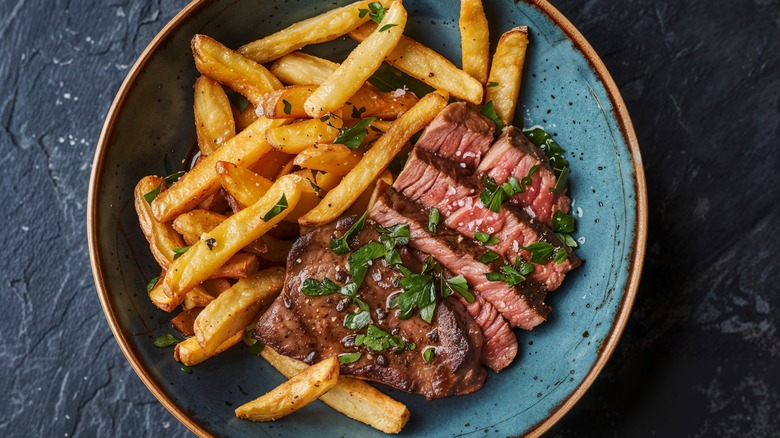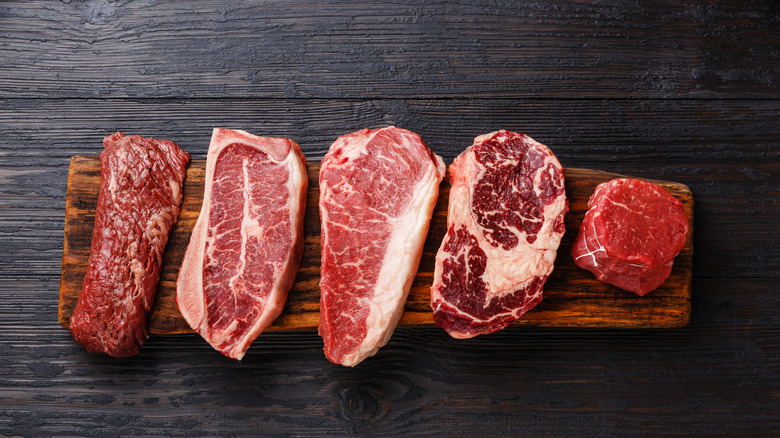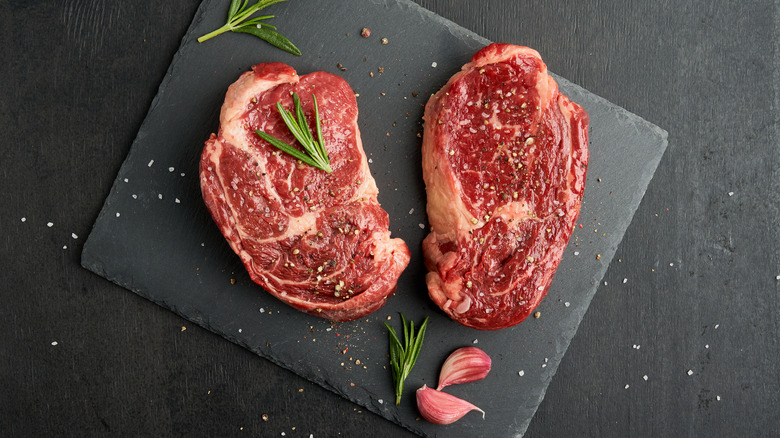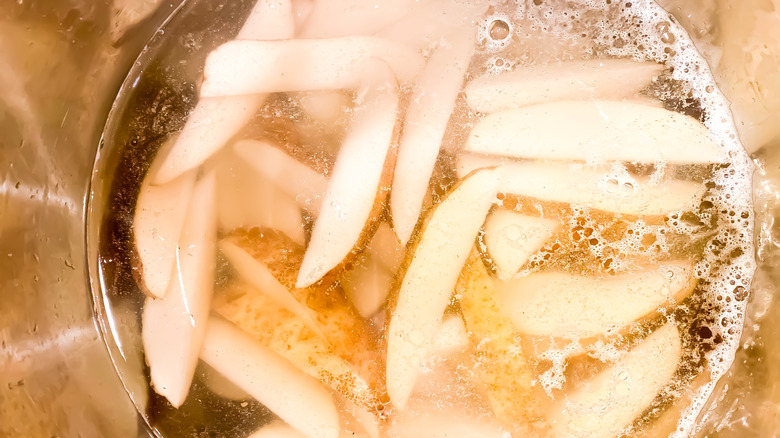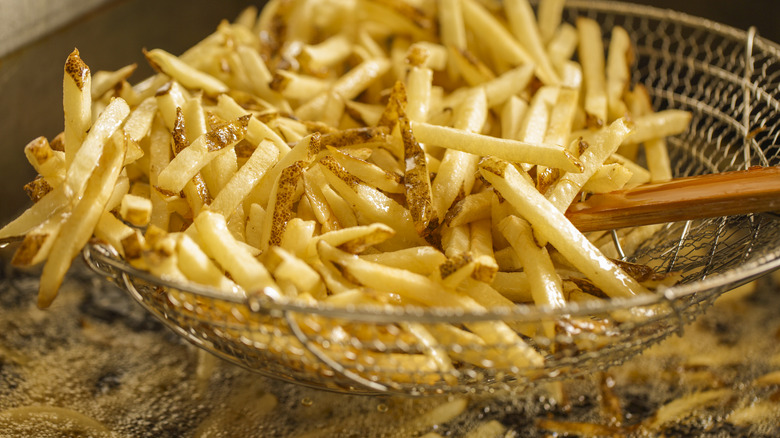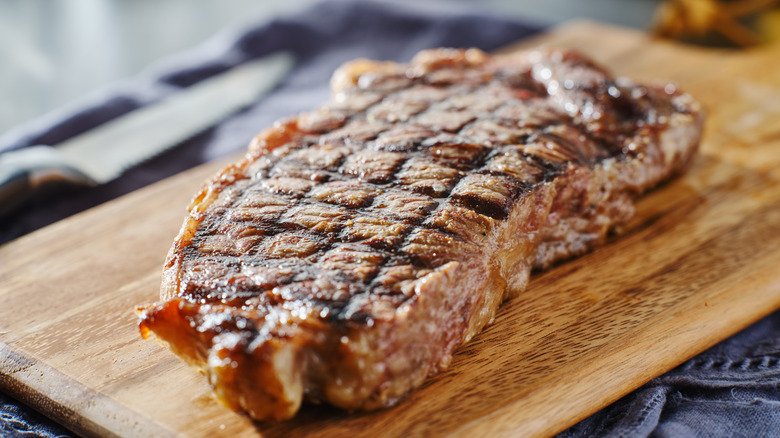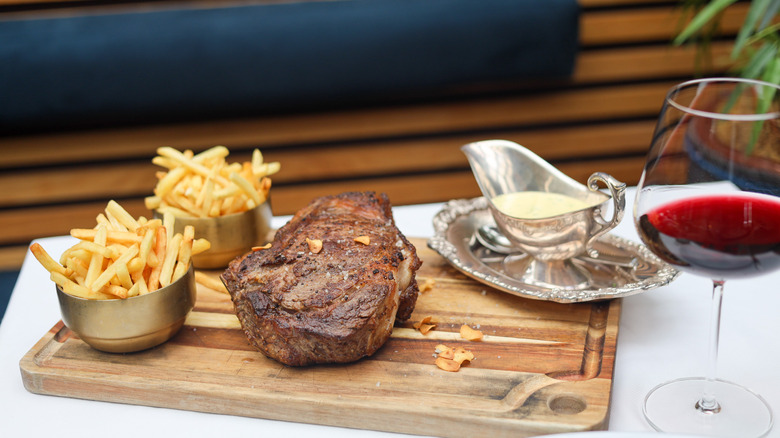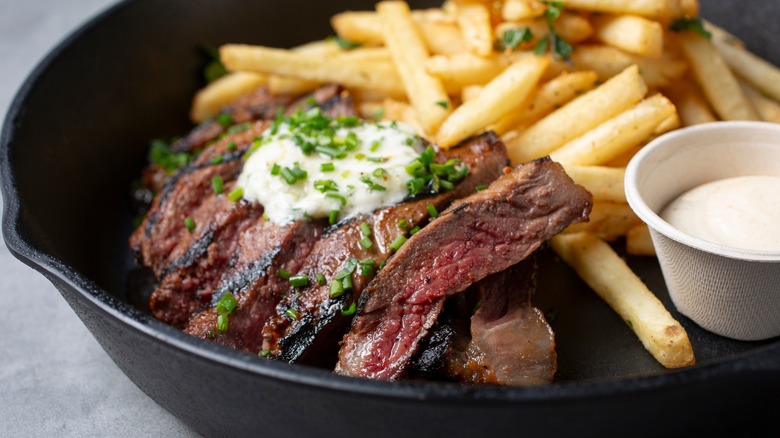8 Tips For Making Restaurant Quality Steak Frites At Home
When you think of classic French bistro fare, steak frites is likely one of the first dishes that comes to mind. Perfectly cooked steak paired with crispy, golden brown french fries served with a compound butter or the restaurant's secret sauce is what bistro menus are made of; a brilliant combination of simple elegance that characterizes French cooking. Though France and Belgium have been in a years long dispute over the origin of steak frites, it seems the dish was first created in Belgium. Despite this, there's no question that French chefs have elevated steak frites to its iconic status as a quintessential item found on French bistro menus everywhere. It's so iconic, in fact, there are many restaurants in Europe and abroad where steak frites is the only dish served.
Though French cooking may have the reputation of being difficult to recreate at home, making steak frites is easier than you might think. Especially, if you know the potential pitfalls to avoid and the secret steps the pros never skip. Chef Matt Baker of the Michelin starred restaurant Gravitas, chef Jonathan Dearden of Bistro du Jour, and chef Sebastien Giannini of L'avant Garde have mastered the art of steak frites. They shared their tips to help you turn your home kitchen into your personal bistro.
Choose the right cut of meat
The first step to making excellent steak frites is choosing the right cut of meat. Different cuts of steak will produce different levels of tenderness and flavor, and for steak frites, you want a cut that's tender enough to cook quickly at relatively high heat without drying out. Steaks cut from the rump were once used for steak frites, but today hangar steak and other cuts are more common.
"Ribeye steak is best, especially bone in," according to chef Sébastien Giannini. "While ribeye is often preferred for general steak consumption, steak frites traditionally features a smaller cut like flat iron steak," said chef Matt Baker. Cuts like porterhouse and flank steak are also popular choices. Chef Jonathan Dearden agrees that cuts like New York Strip or ribeyes are great options, but his "favorite, go-to steak for this dish is bavette, which has the texture of skirt steak and the flavor of flank steak."
Whatever cut you choose, it's important to use well-marbled meat. Marbling refers to the white strips of fat that run through beef. When the steak is cooked, the fat melts into the meat making it moist and juicy. You should also choose a steak that's at least an inch thick. Thinner steaks will cook before a delicious crust can form.
Rest your steak before you cook it
Cooking steak straight from the fridge might not seem like a problem, but it's a common mistake that can lead to less than ideal results. You risk ending up with an improperly cooked steak with a diminished taste and texture. For best results, pull your steak out of the fridge and allow it to come to room temperature before you cook it.
"It is very important to always cook a steak that has been brought up to room temperature," says chef Sébastien Giannini, who asserts this gives the fat "time to melt into the meat a little before cooking." When cold meat hits a hot pan or grill, the drastic temperature change can cause the meat to toughen. Cooking steak from cold can also cause your steak to cook unevenly, leaving you with steak that's overdone on the surface and undercooked in the center. The colder your steak is, the longer it will take for the center to reach the appropriate temperature. By that time, the outside of your steak may be burnt.
Soak the potatoes
There's more to frying the perfect French fries or frites than just dropping cut potatoes into hot oil. Like many cooking techniques, frying potatoes requires you to take a few extra steps to ensure your fries cook up just right. The goal is frites that are golden brown and crunchy on the surface, yet soft in the center. There's one step that can help you achieve French fried perfection and make better French fries at home, and you don't want to skip it.
Soaking your potatoes in water before you cook them is your secret weapon against soggy fries. Potatoes contain starch and when they're sliced, they release that starch, which can create a sticky layer on the surface. When cooked, the starch can prevent your fries from crisping, leaving you with soft, soggy frites instead of fries that are firm and crisp.
Cut your fries evenly and soak them in cold water for at least 15 to 30 minutes. You can soak them longer — some cooks will go as far as soaking potatoes in water for eight hours — but even a short soak will work. Be sure to remove the potatoes from the water and pat them completely dry before cooking them.
Fry the potatoes twice
Second time's a charm when it comes to frying French fries or frites. Once you've cut your potatoes and soaked them in cold water. Frying them is the next step, and for fries that are the perfect blend of crunchy and fluffy, you need to fry them twice. It might seem like overkill, but each dip in the hot oil serves a unique purpose that yields the ideal frites you'll want to pair with your steak.
Spend a few minutes making sure your potatoes are completely dry. Any moisture left will cause a dangerous spattering of hot oil when the wet fries are added. The initial fry, which cooks the center of the fries, should be done in oil at a lower temperature, between 250 F and 325 F. Remove the fries from the oil and place them on a baking sheet lined with paper towels to allow the excess oil to drain away. After the first fry, you can leave your partially-cooked frites at room temperature for as long as four hours before finishing them with their final fry.
Turn up the heat this go-round as this is what will give your fries their crunch. Aim for an oil temperature of 375 F. The second fry quickly seals the outer layer, locking in moisture without absorbing too much extra oil. Double frying guarantees frites that are evenly cooked, beautifully crisp, and hold up well, so you can dip them in your sauce of choice with ease.
Put your thermometers to use
Getting the temperatures right is key to making restaurant-quality steak frites at home. In a commercial kitchen, cooks are typically trained to know when steaks are cooked to the appropriate temperature. You may have seen them gently press a clean finger onto the surface of a steak, judging its level of doneness by the resistance they meet. They can also tell when a pot of hot oil or a deep fryer is hot enough to properly cook their frites. If you haven't mastered this art at home, don't worry. Using a deep frying thermometer and an instant read meat thermometer ensures you get the temperatures right for both your frites and the steak.
Deep frying thermometers typically measure temps up to 400 F, so they are an excellent tool to test the oil before you add your fries. You'll be able to heat your oil to the precise temperature you need for both frying sessions. They can also do double duty as candy thermometers, as many of those recipes also require cooking at high temperatures. An instant read meat thermometer can give you the exact internal temperature of your steak in a matter of seconds. Precision is key for both your steak and frites and using the appropriate thermometer can help you avoid under- or overcooking both.
Rest the steak after cooking
One way to ruin a perfectly cooked steak is to remove it from the pan or grill and immediately cut into it. You'll likely end up with a puddle of juices on your cutting board and a steak that's dry and grainy. Allowing a steak to rest after it's cooked can prevent this. Resting a steak after cooking simply means allowing it to sit or rest at room temperature before you slice into it.
"Probably the most important part of cooking any piece of meat is letting it rest after cooking," according to chef Jonathan Dearden. "This helps with carryover cooking and redistributing the natural juices of the steak, maintaining the moisture." Chef Matt Baker tells Tasting Table that resting also helps with the finished doneness. Steak temperature will continue to rise as it rests, because external temperature transfers from the outside of the steak to the cooling interior.
When a steak is cooked, the heat causes the protein to tighten, forcing the moisture inside to the surface. Resting allows the meat to relax and the moisture to settle back into the steak. The resting time is dependent on the size of your protein, particularly the thickness when you're cooking steak. You should rest your steak for at least 5 minutes for each inch of thickness. Tent your steak with foil to keep it warm as it rests.
Don't forget the sauce
The sauce doesn't get top billing in steak frites' name, but a tasty sauce adds richness and flavor to the dish, giving you the perfect storm of texture and taste. Steak and fries alone are great, but a delectable sauce elevates steak frites to another level of deliciousness.
Sauce options for steak frites can run the gamut from a simple pan sauce to the many 'secret sauces' restaurants serve with it. You can also rely on your favorite French sauces, like a green peppercorn sauce, for inspiration. Chef Matt Baker serves steak frites with a pan sauce, with finely chopped shallots, minced garlic, and a generous amount of butter prepared in the same pan used to cook the steak. However, his go-to sauce for steak frites is a bearnaise sauce. He calls it a "sexier version of hollandaise" that's "perfect for eating with fries and steak." Chef Sébastien Giannini also prefers a bearnaise sauce with steak frites, "especially when it's made fresh."
Chef Jonathan Dearden serves his frites with a herbed sauce: "I personally like to grab a few fries and a piece of steak and dip into the tarragon aioli all together. It's so delicious."
Consider compound butter
If making a sauce for steak frites is outside of your zone of genius in the kitchen, you can serve it with a flavorful compound butter instead. Compound butters are simply softened butter enhanced with the addition of herbs, spices or other ingredients like minced garlic or shredded or softened cheese. Once the butter's easy to spread, stir your other ingredients in until they're well-mixed and you're done.
Compound butters are also known as finishing butters, as they are typically added to food at the end for a final burst of flavor. They can be as simple as the classic French maître d'hôtel butter, which is made with salt, lemon juice and zest, and chopped parsley, or you can whip up your own mouth-watering compound butters with your favorite ingredients.
Add a dollop of the butter on the finished steaks while they're hot so the butter will "melt luxuriously over the hot steak, enhancing its flavors," says chef Matt Baker who considers compound butter "a classic and traditional accompaniment." Chef Jonathan Dearden serves steak frites with compound butter and recommends this instead of a sauce. "Although it will be good to have a sauce, it will take away from the simplicity of the fries and the flavor of the steak," he says. Whichever you choose, compound butters are a delicious and easy sauce alternative for steak frites.
